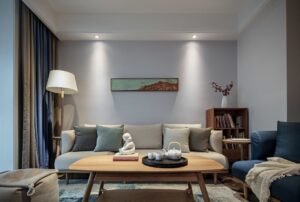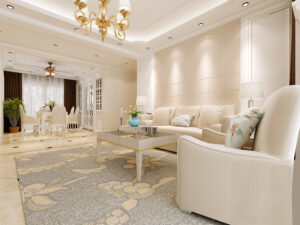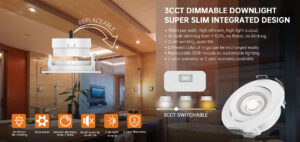In de huidige snel veranderende werkomgevingen, lichtkwaliteit gaat niet langer alleen over helderheid – het gaat over comfort, productiviteit en welzijn. Een cruciale maar vaak over het hoofd geziene maatstaf op dit gebied is de Unified Glare Rating (UGR), een gestandaardiseerde maat voor schittering in verlichtingssystemenOmdat organisaties steeds meer prioriteit geven aan de gezondheid en efficiëntie van hun medewerkers, is inzicht in UGR essentieel geworden voor architecten, facility managers en bedrijfsleiders.
Wat is Unified Glare Rating (UGR)?
UGR, wat staat voor Unified Glare Rating, is een maatstaf voor het beoordelen van het verblindingseffect van binnenverlichtingssystemenHet beoordeelt specifiek 'psychologische' schittering, die storend is maar niet per se de visuele prestaties vermindert. De UGR is een maatstaf voor de subjectieve reactie op het licht dat door een verlichtingsapparaat wordt uitgezonden in een visuele omgeving die ongemak veroorzaakt voor het menselijk oog. Deze classificatie helpt lichtontwerpers bij het beheersen van de mate van schittering in een verlichte omgeving, waardoor een visueel comfortabelere ruimte ontstaat voor de aanwezigen. UGR-waarde is een belangrijke parameter van lampenen volgens de Europese aanbeveling voor binnenverlichting norm EN 12464-1, geldt: hoe lager de UGR-waarde, hoe beter het visuele comfort.
UGR-schaal en de implicaties ervan
De UGR-schaal loopt van 10 tot 30, waarbij hogere waarden duiden op meer ongemak:
- 10: Onmerkbare schittering
- 13: Net waarneembaar
- 16: Waarneembaar
- 19: Net acceptabel
- 22: Onacceptabel
- 25: Gewoon ongemakkelijk
- 28: Ongemakkelijk
Voor de meeste binnenomgevingen is een UGR van 19 of lager wordt als acceptabel beschouwd.
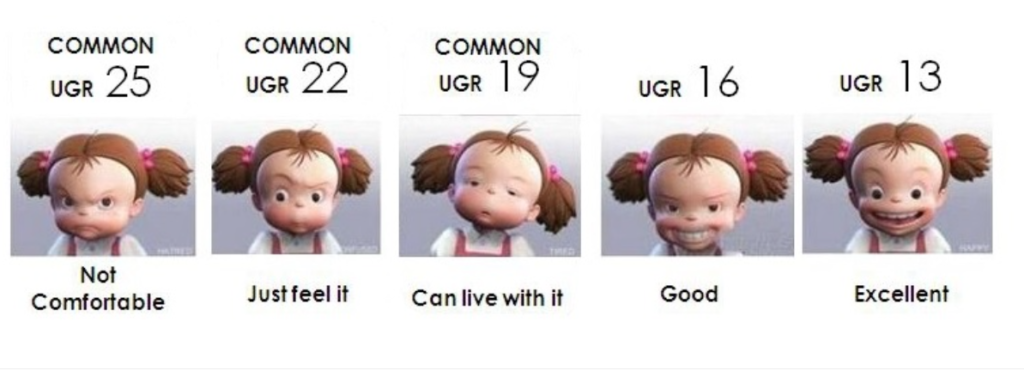
Wat zijn de belangrijkste voordelen van een lage UGR?
Begrijpen van de Unified Glare Rating (UGR) biedt verschillende belangrijke voordelen, die voornamelijk verband houden met het verbeteren van comfort, productiviteit en welzijn in binnenomgevingenHier is een samenvatting van de belangrijkste voordelen:
- Verbeterd visueel comfort: UGR helpt schittering te minimaliseren, waardoor ongemak en belasting van de ogen tijdens visuele taken worden verminderd, wat leidt tot een comfortabelere omgeving.
- Verbeterde productiviteit: Door schittering te verminderen, draagt UGR bij aan een betere concentratie en focus op de werkplek, wat uiteindelijk de productiviteit verbetert.
- Gezondheid en welzijn: Door UGR te beheersen, wordt een gezonder binnenklimaat bevorderd door het verminderen van vermoeidheid van de ogen, hoofdpijn en mogelijke gezichtsproblemen veroorzaakt door langdurige blootstelling aan veel schittering.
- Naleving van regelgeving: Door u te houden aan UGR-normen, voldoet u aan de regelgeving inzake veiligheid en gezondheid op de werkplek. Vaak zijn er specifieke UGR-limieten vastgesteld.
- Energie-efficiëntie: kiezen voor LED-panelen met lagere UGR-waarden kunnen de energie-efficiëntie verbeteren door verlichting effectiever te gebruiken en zo energieverspilling te verminderen.
- Esthetiek en sfeer: UGR-overwegingen dragen bij aan een visueel aantrekkelijke omgeving door schittering te minimaliseren, waardoor verlichtingsarmaturen naadloos op elkaar aansluiten
Wat zou UGR beïnvloeden?
Verschillend verlichtingsarmaturen Kan de Unified Glare Rating (UGR) aanzienlijk beïnvloeden door factoren zoals grootte, vorm, hoek en kleurtemperatuur. 8 Hier ziet u hoe verschillende aspecten van verlichtingsarmaturen de UGR beïnvloeden:
Lichtgevend oppervlak: Armaturen met grotere lichtgevende oppervlakken, zoals panelen van 2'x4', hebben de neiging om lagere UGR-waarden te hebben vergeleken met kleinere armaturen zoals 1'x4' of 2'x2'.
- Lichtopbrengst: Armaturen met een lagere lichtopbrengst helpen om acceptabelere UGR-scores te behalen. Een hogere lichtopbrengst gaat gepaard met een hogere UGR.
- Lichtverdeling: Producten met een lagere candela bij een hoek van 60 graden en hoger, vergeleken met volumetrische verdelingen, hebben de voorkeur. Kleinere lichtbundelhoeken resulteren in een lagere UGR1. Asymmetrische lichtverdeling kan de Glare Rating (GR), die gerelateerd is aan UGR, effectief verlagen.
- Optiek en afscherming: Voor armaturen met een kleine opening (downlights) dient men voor goed afgeschermde optiek te kiezen.
- Montage en positionering: Hogere plafonds en een hogere positionering van de armaturen kunnen bijdragen aan acceptabelere UGR-scores. Het vermijden van lampen in interferentiegebieden kan de UGR ook minimaliseren.
- Bescherming tegen schittering: hoe hoger de GF-waarde, hoe beter de installatie de schittering beperkt.
Volgens een DesignLights Consortium (DLC) Factsheet, de factoren die de UGR beïnvloeden, zijn onder andere de gemiddelde luminantie van armaturen. Acuity Brands geeft ook aan dat hogere lumenwaarden een negatieve invloed hebben op de UGR-waarden.

Wat meet UGR?
UGR kwantificeert de hinderlijke schittering die een gemiddelde waarnemer in een bepaalde ruimte ervaart. Deze hinder kan leiden tot visuele vermoeidheid, verminderd zicht en verminderde productiviteit. Het UGR-systeem houdt rekening met verschillende factoren, waaronder de luminantie van lichtbronnen, hun positie ten opzichte van de waarnemer, de afmetingen van de ruimte en de oppervlaktereflectie.
Onaangename schittering kan een aanzienlijke impact hebben op het comfort en de efficiëntie van een werkplek. Door UGR te begrijpen en te beheersen, kunnen lichtontwerpers omgevingen creëren die zowel productief als aangenaam zijn.
UGR-waarden en hun betekenis
UGR-waarden variëren doorgaans van 10 tot 30, waarbij lagere waarden duiden op minder schittering en beter visueel comfort. Bijvoorbeeld een UGR onder 19 wordt als geschikt beschouwd voor de meeste kantoorwerkzaamheden, terwijl waarden boven 25 Kan ongemak veroorzaken. Hier is een overzicht van de aanbevolen UGR-waarden voor verschillende omgevingen:
| Omgeving | Aanbevolen UGR |
|---|---|
| Kantoor | ≤ 19 |
| Klas | ≤ 16 |
| Industrieel | ≤ 22 |
| Gangen | ≤ 28 |
UGR berekenen
De UGR-berekening maakt gebruik van een formule die rekening houdt met de luminantie van lichtbronnen, de achtergrondluminantie en de ruimtehoek van de armatuur ten opzichte van de waarnemer. Deze formule zorgt ervoor dat UGR-waarden binnen het standaardbereik vallen. Vaak wordt gespecialiseerde software gebruikt om verschillende verlichtingsopstellingen te simuleren en de resulterende schittering te berekenen.
Minimaliseren van UGR voor beter visueel comfort
Om UGR te verminderen en het visuele comfort te verbeteren, kunnen verschillende strategieën worden ingezet:
- Gebruik armaturen met lagere lumenpakketten of grotere lichtgevende oppervlakken.
- Kies armaturen met goed afgeschermde optiek om directe schittering te verminderen.
- Verhoog de reflectie van het kameroppervlak om de achtergrondluminantie te verbeteren.
- Optimaliseer de armatuurafstand en montagehoogte om schittering te minimaliseren.
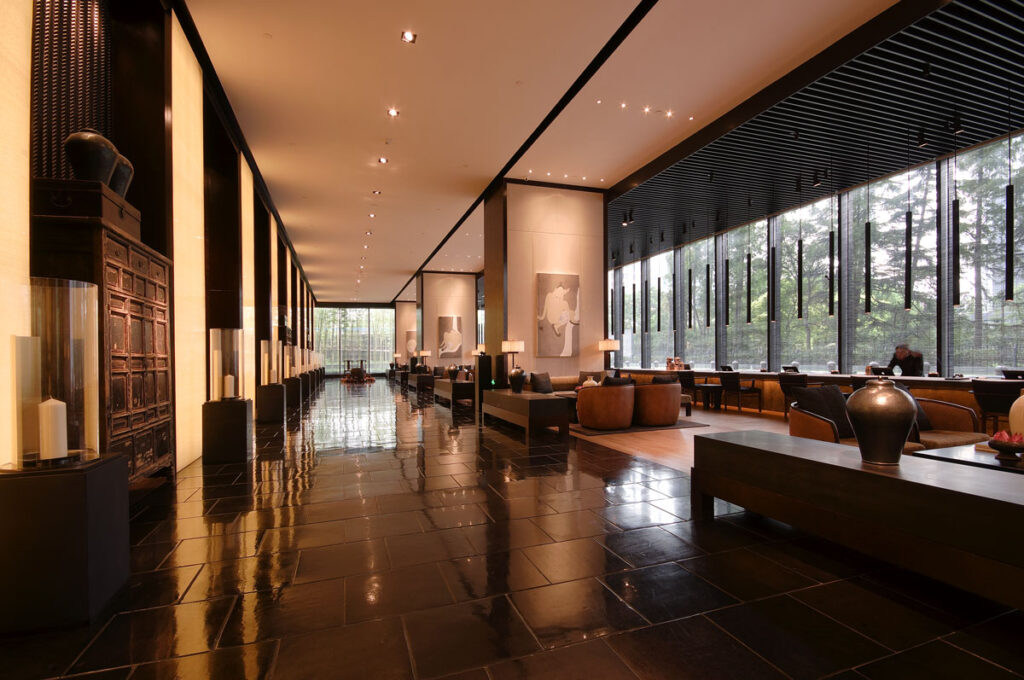
De toekomst van UGR: trends om in de gaten te houden in 2025 en daarna
Naarmate de technologie vordert, wordt UGR steeds meer geïntegreerd in slimme gebouwsystemenInnovaties zoals AI-gestuurde lichtregeling en biofiele ontwerpprincipes verleggen de grenzen van wat mogelijk is. Zo kan AI nu de lichtomstandigheden in realtime voorspellen en aanpassen om optimale UGR-niveaus gedurende de dag.
Bovendien beginnen regelgevende instanties UGR-naleving verplicht te stellen. De bijgewerkte Werkplekrichtlijn van de Europese Unie, die in 2026 van kracht wordt, vereist dat alle nieuwe kantoorgebouwen aan een maximale UGR van 19 voldoen. Naar verwachting zullen wereldwijd vergelijkbare regels worden ingevoerd, waardoor UGR een hoeksteen wordt van het ontwerp van werkplekken.
Optimalisatie van verlichtingsoplossingen met Radians
Radialen zijn een professionele verlichtingsfabrikant gespecialiseerd in LED-verlichtingsoplossingen, inbegrepen LED-downlights, LED-paneelverlichting, LED-railverlichting, En wandlampen. Hun anti-reflecterende oogbeschermingsserie is vooral opmerkelijk vanwege zijn lage UGR functies, waardoor het ideaal is voor onderwijs, kantoor, En tentoonstellingsverlichting omgevingen.
Innovatie en kwaliteitsborging
Radians geeft prioriteit innovatie En hoogwaardig productontwerpDe fabriek implementeert een uitgebreid kwaliteitscontrolesysteem, waarbij wordt gewaarborgd dat aan strenge normen wordt voldaan grondstoffen naar afgewerkte productenDeze toewijding aan kwaliteit garandeert dat al onze verlichtingsoplossingen voldoen aan de hoogste normen op het gebied van prestaties en veiligheid.
Verkenning van UGR-kennis en -producten
Voor degenen die meer willen weten over UGR (Unified Glare Rating) en de toepassingen ervan in verlichting, of voor gedetailleerde informatie over de producten van Radians, klantenservice is beschikbaar om hulp en inzichten te bieden.
Conclusie
Begrijpen en beheren Unified Glare Rating (UGR) is essentieel voor het creëren van comfortabele en productieve binnenomgevingen. Door zorgvuldig te selecteren armaturenDoor hun plaatsing te optimaliseren en rekening te houden met de kenmerken van de ruimte, kunnen ontwerpers effectief de hinderlijke schittering minimaliseren en zo de algehele kwaliteit van de ruimte verbeteren. binnenverlichting.
Veelgestelde vragen
Wat is UGR en welke invloed heeft het op het verlichtingscomfort binnenshuis?
UGR, of Unified Glare Rating, meet de hinder die wordt veroorzaakt door schittering van verlichtingsarmaturen. Het is cruciaal voor een comfortabele omgeving. binnenverlichting in ruimtes zoals kantoren en woningen in heel Europa, waaronder Zweden, Denemarken en het Verenigd Koninkrijk. Een lagere UGR-waarde duidt op minder schittering, wat het visuele comfort verbetert en de belasting van de ogen vermindert. Ga voor meer informatie over onze UGR-conforme producten naar onze binnenverlichting sectie.
Wat zijn veelvoorkomende misvattingen over UGR in lichtontwerp?
Een veelvoorkomende misvatting is dat UGR de mate van hinderlijke schittering meet, wat van invloed is op de visuele prestaties. UGR richt zich echter specifiek op hinderlijke schittering, die hinder veroorzaakt maar het zicht niet belemmert. Het begrijpen van dit onderscheid is essentieel voor effectief lichtontwerp. Deel uw ervaringen met UGR in onze reviews om anderen te helpen weloverwogen beslissingen te nemen.
Welke unieke voordelen biedt Radians Lighting ten opzichte van concurrenten op het gebied van UGR-conformiteit?
Radians Lighting onderscheidt zich door een breed scala aan UGR-conforme producten, afgestemd op de Europese normen. Deze producten garanderen niet alleen naleving, maar ook superieur visueel comfort. Onze focus op design en kwaliteit zorgt ervoor dat onze verlichtingsoplossingen zowel esthetisch aantrekkelijk als functioneel zijn, waardoor ze ideaal zijn voor woningen en kantoren in heel Europa. Bekijk onze bestverkochte UGR-conforme producten voor meer details.



